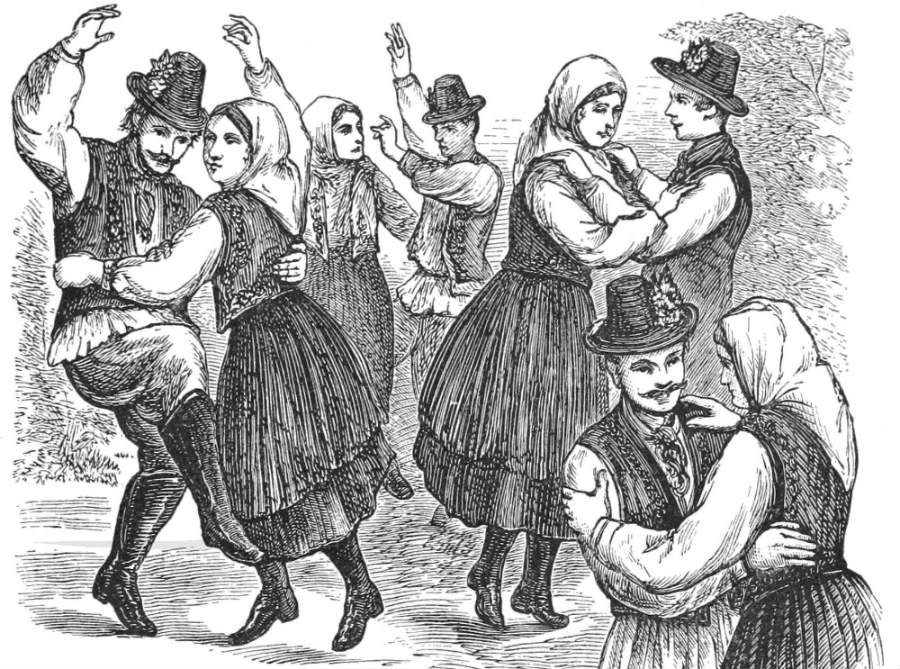In the course of the nineteenth century, folk elements started becoming more and more prominent within classical music compositions, adding a little bit of color to a genre that otherwise would have been mathematically perfect, but a little cold at times. One of the most successful examples of this contamination is the csardas, the Hungarian folk dance whose names derives from csárda, meaning tavern–even though it originated as a recruiting dance by the Hungarian army in the 18th century.
You can easily recognize a csardas by the variation in tempo: it starts out in a slowly (a section that is called the lassú) and progresses to a very fast tempo (fríss, “fresh”)–of course, this variation is not a binary system: some csardas even display seven changes in tempo. It is fairly interesting to see how classical composers adapted this famous Hungarian folk dance to their body of work, so we rounded up six examples of classical music csardas you should know about. That said, however, the original folk csardas, the actual dance, has been enjoying a revival in Hungary, so make sure you check the táncház movement out.
Brahms, Hungarian Dance no. 5 (1869)
Johannes Brahms wrote a set of 21 lively Hungarian Dances based on Hungarian traditional themes; those dances would eventually influence the development of ragtime. No. 5 in F Sharp minor is perhaps the most famous one, and it derives its themes from a csardas by Béla Kéler, which Brahms actually mistook as a folk song. We chose this performance by David Garrett for its folk vibe.
Johann Strauss, II Klänge der Heimat (1874)
In Die Fledermaus, each character is invited to the infamous ball hosted by cross-dressing prince Orlovsky without the others knowing about it. In particular, Gabriel von Eisenstein is invited to the ball by his friend Falke and goes there instead of surrendering to the police (for eight days only!) while leaving his wife Rosalinde behind. However, Falke invites von Rosalinde as well, so she can see her husband flirt with other ladies. For this reason, she attends the event disguised as a Hungarian countess, and, when Falke introduces this foreign noblewoman to von Eisenstein, she sings a soulful csardas that describes the beauty of her supposed homeland. This song, titled Klänge der Heimat (sounds from homeland) is perhaps the most famous csardas set to song. In pure csardas fashion, it starts out somber and literally ends with a bang.
Tchaikovsky, Swan Lake Act III (1876)
The third act of Tchaikovsky’s Swan Lake contains a sequence of five folk dances: the Hungarian dance, the Russian dance, the Spanish dance, the Neapolitan dance, and the Mazurka. They were performed after all six of Siegrfried’s potential brides were brought to court with Dancers wearing (mostly) traditional costumes and performing steps typical of those dances. The Hungarian dance features the variation moderato assai–allegro moderato–vivace.
Sarasate, Zigeunerweisen (1878)
Zigeunerwiesen by Spanish composer Pablo de Sarasate features themes of the Roma people and wraps up with the typical rhythms of csardas –it goes like this: moderato, lento, un poco più lento, allegro molto vivace. This last section actually echoes a theme that Liszt employed in his Hungarian Rhapsody no. 13, which dates 40 years before the premiere of Zigeunerweisen.
Liszt, Csardas Macabre (1881-2)
Franz Liszt wrote three csardas for piano later in his career (between 1881 and 1884). Curiously, unlike his past experimentations with Hungarian music such as the Verbunkos and the Hungarian Rhapsodies, he did not treat the genre as freely. These csardases come in strange sonorities that can tempt the listener to associate them with atonal music. The most famous Lisztian csardas is the Csardas Macabre, which follows the sonata form and, in the second movement, it either quotes the dies Irae or a Hungarian folk song, depending on whom you ask. Sorry, no fiddle or violin here. Liszt’s csardas are piano pieces.
Vittorio Monti, Czardas (1904)
Perhaps the most virtuosic csardas in the classical repertoire, this rhapsodical concert piece was originally composed for violin, piano, and mandolin (after all, Vittorio Monti was a mandolinist). Even though it features an average length for csardas, it contains seven sections, each one with a different tempo: andante largo, allegro vivo, molto meno, meno quasi lento, allegro vivace, allegretto and finally molto più vivo. Despite all these variations, a little bit of rubato is expected to give the piece even more panache. Oh, and it goes from Pianissimo to Fortissimo.

